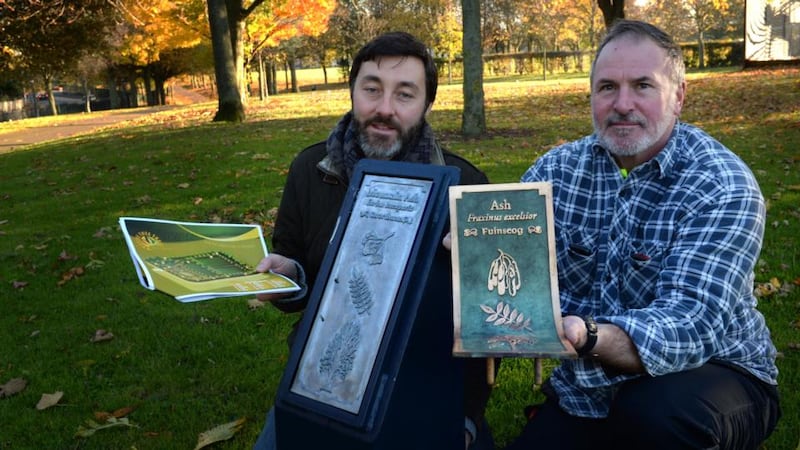You’d think it should be quite easy to recognise tree species. Unlike many plants, trees are big and obvious. Unlike birds and mammals, they don’t fly, run or hide when you approach them. So you can carry a field guide right up to a tree and check it against likely species there and then; you can take detailed photographs at your leisure, or bring a leaf or fruit home for further study.
In fact, however, many trees are very tricky and can baffle even experts. I remember asking a National Parks and Wildlife Service guide, on a public tree walk in Glendalough, whether a particular tree was a silver birch or a downy birch. It seemed to have many of the characteristics of both species.
“I’d have to take it to the lab for analysis,” she said frankly. “They hybridise so much it can be impossible to tell them apart in the field.”

Happily, however, most of our native trees are pretty easy to put a name on, especially if you are content to know that the exquisitely tactile silvered and peeling bark in front of you belongs to a birch; let the experts worry about its more precise identity.
And there are not very many native trees: just 20 or so, depending on how strictly you distinguish trees and shrubs. Hawthorn, for example, often figures on lists of both.
So although most of us will never be able to recognise every native bird on sight, much less every native plant or insect, it’s quite feasible for every schoolchild to grow up familiar with our indigenous trees.
That’s why Dublin City Council’s native-tree trails are such a good idea, at least in principle. So far, nine of the council’s 50-odd parks have developed tree trails in the past five years, and each one gives you an opportunity to find up to 15 native trees in the course of a short walk.
The council’s website links to informative guides, in English and Irish, to each trail and its species. You might be puzzled initially, though, by a large blank space, where you could expect an illustration, on the information page dedicated to each tree. But this blank space connects directly to an interaction: not on your screen but in the park when you find the tree.
On most of the trails, which are a work in progress, the council has installed little oak signposts, set in cobblestones. A bronze plaque on the post offers the name of the tree as well as images of its overall shape, its leaf and its fruit standing out in relief. You use the blank page in the guide to make a rubbing of these reliefs, and so you have your own image of each tree’s main features.
Many children enjoy taking rubbings, and it’s very popular for schools near the parks to do this during National Tree Week every March. It’s a hands-on way for a child to get to know the shape of a leaf, nut or canopy. And they will be reminded of the trees every time they see them on their bedroom or classroom wall.
Unfortunately, however, the plaques also caught the attention of some other people, for all the wrong reasons.
Donal O’Connor, a gardener at the Markievicz Park in Ballyfermot, in west Dublin, recalls that a ranger came into the park early one morning, about 18 months after the signposts were installed, and found that one plaque was missing. He checked the others and found that efforts had been made to prise every one off its wooden base.
He removed them all as a precaution. But a few days later all the plaques were stolen from Bushy Park in Rathgar.
“The thieves must have used our guide maps,” says Sean Redmond, the parks supervisor for Dublin South-Central. “This is a much bigger park, and the signposts would have been quite hard to find at night.”
The plaques are detailed and attractive, and each costs €400 to make. Their value, when melted down, might be only a quarter of that, but 15 of them would make a tidy night’s illicit profit. As many sculptors know, bronze left out in public is a magnet for criminals, especially in a recession.
So the roll-out of plaques had to stop, and most parks no longer have them. You can still walk the trails with the guide on a smartphone or, better, a tablet. But the maps are inevitably rather imprecise, and you’d need to know your trees pretty well to pick out a single bird cherry or crab apple among a mass of other species. And, of course, you lose the opportunity to make rubbings with your kids.
Dublin City Council’s parks and biodiversity team, headed by Maryann Harris, have not been defeated by this setback. They have explored ways to make the plaques less attractive to thieves, and less easy to steal.
Aluminium-plated plaques, fixed firmly into steel signposts set in concrete, have survived unscathed for six months in Markievicz Park. An experiment with plastic plates is under way at St Anne’s Park in Raheny, north Dublin, and could become the norm for the others if it is successful. Neither option is as handsome as the originals, but perhaps they were a luxury.
Redmond and O’Connor say Markievicz Park had a long history of theft and vandalism. However, redesign by a council landscape architect, Peter Leonard, a decade ago, in which the community was consulted about local preferences, has turned it into a cherished place.
Through activities such as the tree trail, the numerous schools nearby are now all involved with the park, and this is creating a sense of ownership of the place among new generations of children.
See iti.ms/1fIDbdT








